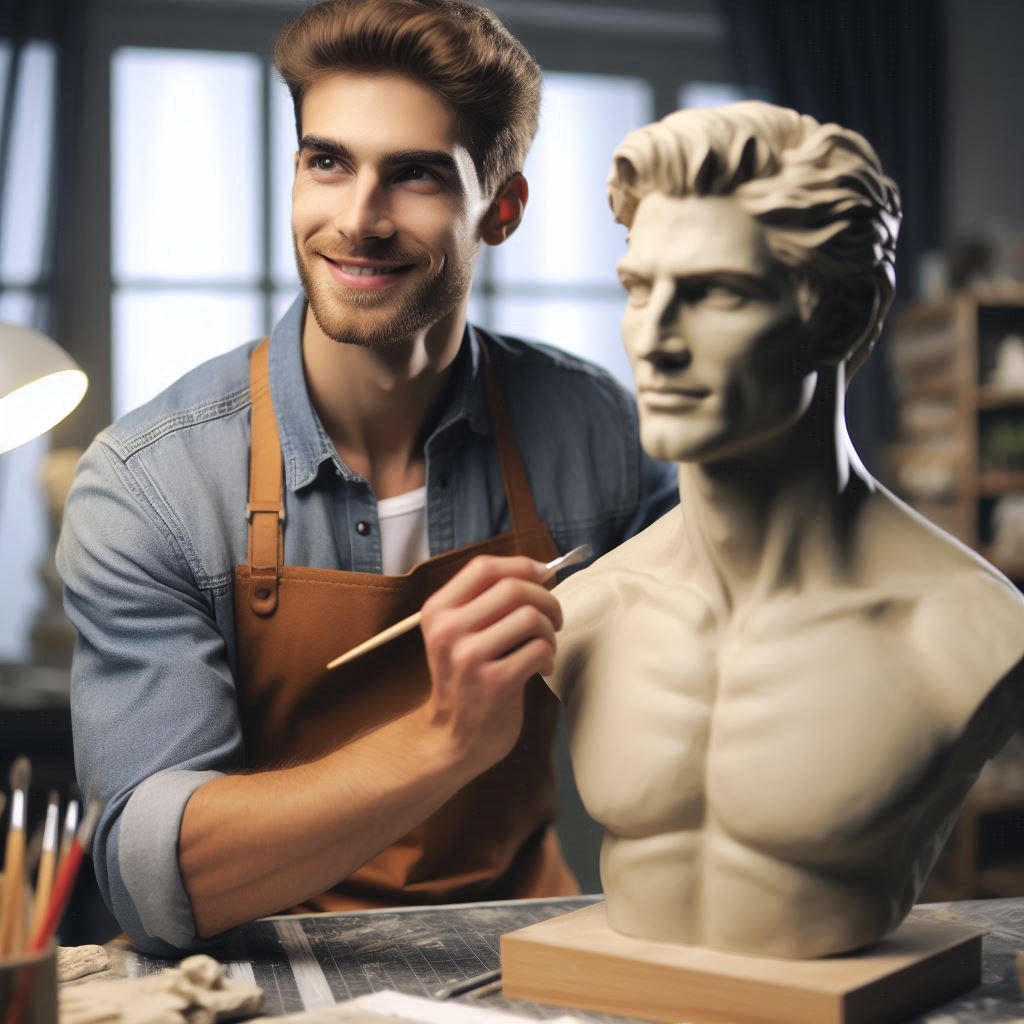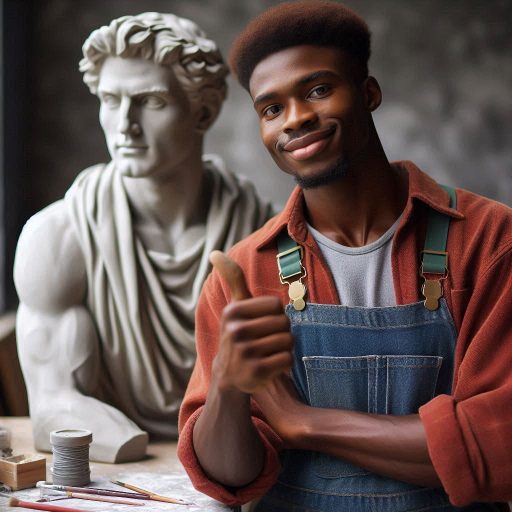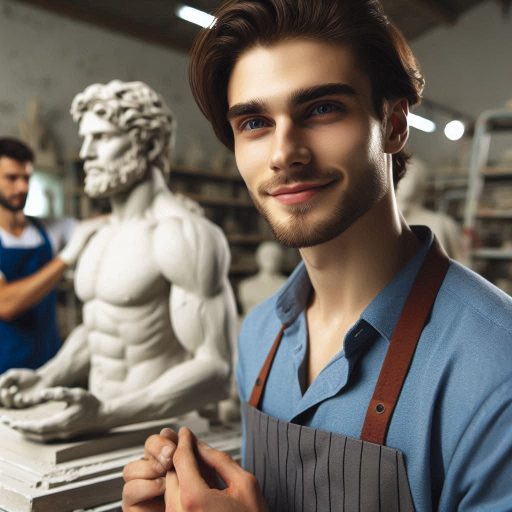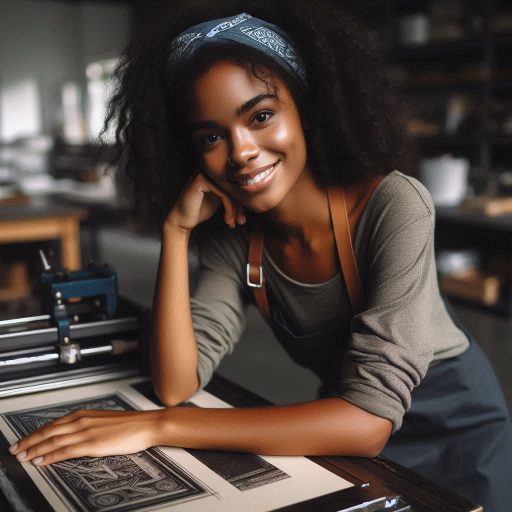Introduction
Preparing for interviews is crucial for aspiring sculptors and designers aiming to land their dream roles.
In this competitive industry, standing out during interviews requires more than just talent.
It’s about presenting yourself as a professional and showcasing your unique artistic vision.
The art world is highly competitive, and many candidates vie for the same positions.
To stand out, preparation is key.
You need to confidently articulate your creative process and passion for design.
Strong interview skills can set you apart and secure opportunities that align with your artistic goals.
Here are some interview tips to help you shine:
- Portfolio Presentation: Curate your best work and explain your artistic choices clearly.
- Research: Understand the company or gallery’s aesthetic and mission.
- Prepare Questions: Ask insightful questions to show your interest in their projects.
- Practice Responses: Be ready to discuss challenges, inspirations, and future aspirations.
By following these tips, you can increase your chances of standing out in interviews and achieving success as a sculptor or designer.
Research the Company
When interviewing for a sculptor or designer position, researching the company is crucial.
This preparation demonstrates your genuine interest and helps you tailor your responses effectively.
Here’s how to make the most of this research.
Importance of Researching the Company
Understanding the company you’re interviewing with shows that you’re committed and well-prepared.
It reveals your enthusiasm for the role and helps you stand out from other candidates.
Knowing the company’s values, culture, and recent projects allows you to align your skills with their needs and expectations.
This insight can significantly boost your confidence and performance during the interview.
Gathering Information about the Company
Start by visiting the company’s website.
Explore their mission statement, core values, and recent news.
This will give you a solid foundation about what the company stands for and its current focus.
Look for any design or sculpture projects they have showcased.
Transform Your Career Today
Unlock a personalized career strategy that drives real results. Get tailored advice and a roadmap designed just for you.
Start NowUnderstanding their portfolio will help you gauge their style and approach.
Utilize social media platforms and professional networks like LinkedIn to find more about the company’s recent activities and achievements.
Join relevant groups or forums to gather additional insights from current or past employees.
Reading reviews and testimonials can also provide a sense of the company’s reputation and work environment.
Incorporating Research into Your Answers
During the interview, weave your knowledge into your responses.
For example, if the company recently launched a new project, mention how your previous work aligns with that project.
Highlight how your skills and experience are well-suited to their current needs and values.
Tailoring your answers to reflect the company’s mission and recent accomplishments demonstrates that you are a well-informed and strategic candidate.
This approach not only showcases your preparation but also indicates your potential for a strong fit within the organization.
By thoroughly researching the company, you not only prepare for the interview but also make a lasting impression.
Read: Choosing the Right Paper for Printmaking
Showcase Your Portfolio
Presenting a strong portfolio is essential during any interview for sculptors and designers.
Your portfolio is the visual representation of your skills, creativity, and artistic journey.
A well-organized portfolio not only captures the interviewer’s attention but also tells your story as an artist.
The Significance of a Strong Portfolio
A solid portfolio can set you apart from the competition.
It demonstrates your range, technical abilities, and artistic vision.
Highlighting your best work will leave a lasting impression on interviewers, showing them you are the right fit.
Selecting and Organizing Your Best Work
When preparing your portfolio, select pieces that represent your strengths.
Include works that showcase your creativity, versatility, and technical expertise.
Showcase Your Business Today
Reach thousands of readers actively exploring professional services. Publish your business profile and grow your audience now.
Publish NowFollow these tips to curate the best collection:
- Choose a variety of works: Display different styles, mediums, or techniques you’ve mastered.
- Prioritize quality over quantity: Fewer impactful pieces are better than many average ones.
- Tailor your portfolio to the job: Customize your selections based on the role you’re applying for.
- Organize your portfolio logically: Start with strong pieces and end with works that leave a lasting impression.
Discussing Your Inspiration and Process
During your interview, be prepared to explain the inspiration and process behind each piece.
This gives insight into your artistic thinking and problem-solving skills.
Here are some ways to effectively discuss your work:
- Explain your creative process: Share how you developed your ideas and brought them to life.
- Discuss materials and techniques: Talk about the tools and methods you used to create each piece.
- Share your inspiration: Reveal what motivated you and how it influenced the final result.
- Highlight challenges: Mention any obstacles you faced and how you overcame them.
By presenting a well-crafted portfolio and confidently discussing your work, you’ll make a lasting impact in your interviews.
Read: Sculpture Materials: A Guide to Choosing the Best

Practice Common Interview Questions
Preparing for an interview as a sculptor or designer is crucial to showcasing your skills and personality.
Below are some common interview questions and tips to help you articulate clear and compelling responses.
Common Interview Questions
- What inspires your artistic style and design choices?
- Can you describe your creative process from start to finish?
- Which materials do you prefer working with and why?
- How do you handle creative block or challenges during a project?
- Tell us about a recent project and what you learned from it.
- How do you incorporate feedback into your work?
- How do you balance artistic vision with client requirements?
- Where do you see yourself in the next five years as a sculptor/designer?
Tips for Preparing Thoughtful Responses
- Reflect on your work: Think about past projects and identify your creative strengths and challenges.
- Showcase your problem-solving: Employers want to see how you overcome obstacles and work under pressure.
- Be specific: Use examples from your portfolio to back up your answers.
- Stay authentic: Let your passion and unique artistic perspective come through in your responses.
- Highlight growth: Emphasize how you’ve improved over time and what you’re learning.
Practice with Mock Interviews
- Find a friend or mentor: Set up a mock interview with someone who can give constructive feedback.
- Focus on clear communication: Practice explaining your creative process in simple, concise terms.
- Record and review: Record the mock interview to assess areas where you can improve.
- Work on body language: Non-verbal communication is key, so maintain eye contact and use confident gestures.
By practicing these questions and refining your answers, you’ll feel more prepared and confident.
Mock interviews can sharpen your communication skills and ensure you present your best self in real interviews.
Read: The Future of Printmaking in Digital Age
Demonstrate Your Problem-Solving Skills
The importance of demonstrating problem-solving skills during the interview
Problem-solving skills are vital for sculptors and designers.
Employers seek candidates who can tackle complex challenges with creativity and precision.
Demonstrating these skills shows you can handle unexpected issues and find innovative solutions.
During the interview, emphasize your ability to adapt and resolve problems effectively.
This capability sets you apart from other candidates, showcasing your readiness for real-world design and sculpting tasks.
Examples of how sculptors and designers can showcase their ability to think creatively and solve complex design challenges
Share specific examples from your portfolio where you faced significant design challenges.
For instance, describe a project where you had to adapt your design due to unexpected material limitations.
Explain how you creatively solved the problem, such as by finding alternative materials or redesigning the structure.
Another example might involve solving spatial constraints in a sculpture, demonstrating how you adjusted your approach to meet the design requirements.
These examples highlight your practical problem-solving skills and innovative thinking.
Tips on discussing your approach to problem-solving in previous projects
When discussing past projects, focus on the steps you took to address challenges.
Start by explaining the problem or constraint you faced.
Next, describe the process you used to explore solutions, including any brainstorming or research methods.
Highlight the final solution and its impact on the project’s success.
Use concrete examples and metrics to quantify the effectiveness of your solution.
Additionally, be prepared to discuss how you learned from the experience and how it has shaped your approach to future projects.
Read: Printmaking Techniques: Woodcut and Linocut
Prepare Questions for the Interviewer
The importance of asking thoughtful questions during the interview
Asking thoughtful questions during your interview is crucial.
It shows your genuine interest in the role and the company.
It also helps you gather important information to determine if the company aligns with your career goals and values.
By asking insightful questions, you demonstrate that you’ve researched the company and are invested in your potential role.
Examples of questions you can ask to demonstrate your interest in the company and the role
Start by asking about the company’s current projects and future plans.
This question reveals your enthusiasm and helps you understand the company’s direction.
For instance, you might ask, “Can you tell me about the exciting projects the team is working on right now?”
This shows you are eager to contribute to significant work.
Aspiring sculptors and designers to inquire about the company culture, future projects, and opportunities for growth
Inquire about the company culture to see if it’s a good fit for you.
Asking about the work environment and team dynamics can provide insight into your potential day-to-day experience.
Consider questions like, “How would you describe the company culture?” or “What do you enjoy most about working here?”
These questions help you gauge if you’ll thrive in their setting.
Showcase Your Business Today
Reach thousands of readers actively exploring professional services. Publish your business profile and grow your audience now.
Publish NowDon’t forget to ask about opportunities for growth and development.
This demonstrates your long-term interest in the role and your desire to advance within the company.
Questions such as, “What opportunities for professional development does the company offer?” or “How does the company support employees in reaching their career goals?” highlight your commitment to your professional growth.
Overall, preparing and asking relevant questions during your interview not only shows your interest but also helps you make an informed decision.
It reflects your proactive approach and seriousness about the position, setting you apart from other candidates.
Dress and Behave Professionally
The importance of dressing professionally for the interview
Dressing professionally is crucial for making a strong first impression.
It shows respect for the interviewer and the opportunity.
Your attire reflects your seriousness about the role and your understanding of industry norms.
Even if the studio environment is casual, presenting yourself in a polished manner demonstrates professionalism and preparation.
It can set the tone for the entire interview and help you stand out from other candidates.
Tips on selecting appropriate attire that reflects your personal style while also fitting the industry standards
Choosing the right outfit involves balancing personal style with industry expectations.
Opt for attire that is neat, well-fitted, and appropriate for the industry.
For sculptors and designers, this might mean wearing something creative yet polished, like a stylish blouse or tailored pants.
Avoid overly casual wear such as jeans or t-shirts. Incorporate subtle elements of your style to show personality, but ensure they do not overshadow professionalism.
Accessories should be minimal and not distracting.
The importance of maintaining a positive attitude, good posture, and respectful behavior throughout the interview
A positive attitude is essential in interviews.
It conveys enthusiasm and a willingness to contribute to the team.
Good posture demonstrates confidence and readiness.
Sit up straight, maintain eye contact, and avoid slouching.
Respectful behavior is equally important.
Address the interviewer politely, listen actively, and respond thoughtfully.
Avoid interrupting and show appreciation for their time.
These non-verbal cues contribute to a professional image and enhance your chances of making a favorable impression.
Conclusion
Aspiring sculptors and designers must remember to showcase their unique style and creativity during interviews.
By demonstrating a passion for their craft and a willingness to collaborate, candidates can make a positive impression on potential employers.
It is essential to research the company beforehand and prepare for common interview questions.
Additionally, practicing discussing their portfolio pieces and explaining their creative process can help candidates present themselves confidently.
Aspiring sculptors and designers should use these interview tips to prepare effectively and leave a lasting impact on potential employers.
By following these guidelines, candidates can increase their chances of securing a position in the competitive field of sculpting and design.
Pursuing a successful career in sculpting and design requires dedication, hard work, and perseverance.
It is crucial for aspiring artists to stay motivated and believe in their talent and abilities.
With the right mindset and preparation, they can achieve their goals and succeed in the creative industry.
[E-Books for Sale]
The Big Book of 500 High-Paying Jobs in America: Unlock Your Earning Potential
$19.99 • 500 High-Paying Jobs • 330 pages
Explore 500 high-paying jobs in America and learn how to boost your career, earn more, and achieve success!
See All 500 High-Paying Jobs of this E-Book
1001 Professions Without a Degree: High-Paying American Jobs You Can Start Now
$19.99 • 1001 Professions Without a Degree • 174 pages
Discover 1001 high-paying jobs without a degree! Unlock career tips, skills, and success strategies for just $19.99!




